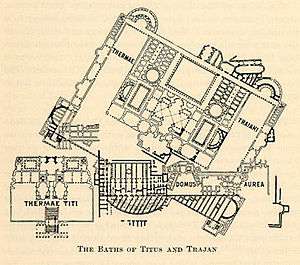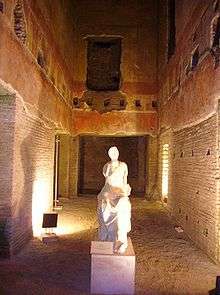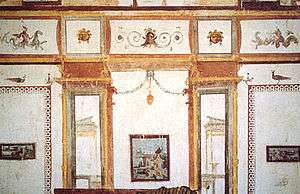Domus Aurea
| Domus Aurea | |
|---|---|
| Location | Regione III Isis et Serap |
| Built in | c. 64-68 AD |
| Built by/for | Nero Claudius Caesar Augustus Germanicus |
| Type of structure | Roman villa |
| Related |
List of ancient monuments in Rome |
 Domus Aurea | |
The Domus Aurea (Latin, "Golden House") was a vast landscaped palace built by the Emperor Nero in the heart of ancient Rome after the great fire in 64 AD had destroyed a large part of the city and the aristocratic villas on the Palatine Hill.[1]

Construction

Suetonius claims this of Nero and the Domus Aurea:
When the edifice was finished in this style and he dedicated it, he deigned to say nothing more in the way of approval than that he was at last beginning to be housed like a human being.[2]

Though the Domus Aurea complex covered parts of the slopes of the Palatine, Esquiline, Oppian and Caelian hills, with a man-made lake in the marshy valley, the estimated size of the Domus Aurea is an approximation, as much of it has not been excavated. Some scholars place it at over 300 acres (1.2 km2),[3] while others estimate its size to have been under 100 acres (0.40 km2).[4] Suetonius describes the complex as "ruinously prodigal" as it included groves of trees, pastures with flocks, vineyards and an artificial lake—rus in urbe, "countryside in the city".
Nero also commissioned from the Greek Zenodorus a colossal 35.5 m (120 RF) high bronze statue of himself, the Colossus Neronis.[2] Pliny the Elder, however, puts its height at only 30.3 m (106.5 RF).[5] The statue was placed just outside the main palace entrance at the terminus of the Via Appia[2] in a large atrium of porticoes that divided the city from the private villa.[6] This statue may have represented Nero as the sun god Sol, as Pliny saw some resemblance.[7] This idea is widely accepted among scholars[8] but some are convinced that Nero was not identified with Sol while he was alive.[9] The face of the statue was modified shortly after Nero’s death during Vespasian’s reign to make it truly a statue of Sol.[9] Hadrian moved it, with the help of the architect Decrianus and 24 elephants,[10] to a position next to the Flavian Amphitheater. This building took the name "Colosseum" in the Middle Ages, after the statue nearby, or, as some historians believe, because of the sheer size of the building.
The Golden House was designed as a place of entertainment, as shown by the presence of 300 rooms without any sleeping quarter. Nero's own palace remained on the Quirinal Hill. No kitchens or latrines have been discovered.
Rooms sheathed in dazzling polished white marble were given richly varied floor plans, shaped with niches and exedras that concentrated or dispersed the daylight. There were pools in the floors and fountains splashing in the corridors. Nero took great interest in every detail of the project, according to Tacitus' Annals, and oversaw the engineer-architects, Celer and Severus, who were also responsible for the attempted navigable canal with which Nero hoped to link Misenum with Lake Avernus.[11]

Some of the extravagances of the Domus Aurea had repercussions for the future. The architects designed two of the principal dining rooms to flank an octagonal court, surmounted by a dome with a giant central oculus to let in light.[1] It was an early use of Roman concrete construction. One innovation was destined to have an enormous influence on the art of the future: Nero placed mosaics, previously restricted to floors, in the vaulted ceilings. Only fragments have survived, but that technique was to be copied extensively, eventually ending up as a fundamental feature of Christian art: the apse mosaics that decorate so many churches in Rome, Ravenna, Sicily and Constantinople.
Celer and Severus also created an ingenious mechanism, cranked by slaves, that made the ceiling underneath the dome revolve like the heavens, while perfume was sprayed and rose petals were dropped on the assembled diners. According to some accounts, perhaps embellished by Nero's political enemies, on one occasion such quantities of rose petals were dropped that one unlucky guest was asphyxiated (a similar story is told of the emperor Elagabalus).
The extensive gold leaf that gave the villa its name was not the only extravagant element of its decor: stuccoed ceilings were faced with semi-precious stones and ivory veneers, while the walls were frescoed, coordinating the decoration into different themes in each major group of rooms.[12] Pliny the Elder watched it being built and mentions it in his Naturalis Historia.[13]
Frescoes covered every surface that was not more richly finished. The main artist was one Famulus (or Fabulus according to some sources). Fresco technique, working on damp plaster, demands a speedy and sure touch: Famulus and assistants from his studio covered a spectacular amount of wall area with frescoes. Pliny, in his Natural History, recounts how Famulus went for only a few hours each day to the Golden House, to work while the light was right. The swiftness of Famulus's execution gives a wonderful unity and astonishing delicacy to his compositions.
Pliny the Elder presents Amulius[14] as one of the principal painters of the domus aurea: "More recently, lived Amulius, a grave and serious personage, but a painter in the florid style. By this artist there was a Minerva, which had the appearance of always looking at the spectators, from whatever point it was viewed. He only painted a few hours each day, and then with the greatest gravity, for he always kept the toga on, even when in the midst of his implements. The Golden Palace of Nero was the prison-house of this artist's productions, and hence it is that there are so few of them to be seen elsewhere."[15]
Damnatio memoriae


After Nero's death, the Golden House was a severe embarrassment to his successors. It was stripped of its marble, its jewels and its ivory within a decade. Soon after Nero’s death, the palace and grounds, encompassing 2.6 km² (c. 1 mi²), were filled with earth and built over: the Baths of Titus were already being built on part of the site in 79 AD. On the site of the lake, in the middle of the palace grounds, Vespasian built the Flavian Amphitheatre, which could be reflooded at will, with the Colossus Neronis beside it.[1] The Baths of Trajan,[1] and the Temple of Venus and Rome were also built on the site. Within 40 years, the Golden House was completely obliterated, buried beneath the new constructions, but paradoxically this ensured the wallpaintings' survival by protecting them from dampness.
Rediscovery
When a young Roman inadvertently fell through a cleft in the Esquiline hillside at the end of the 15th century, he found himself in a strange cave or grotta filled with painted figures. Soon the young artists of Rome were having themselves let down on boards knotted to ropes to see for themselves. The fourth style frescoes that were uncovered then have faded to pale gray stains on the plaster now, but the effect of these freshly rediscovered grottesche[16] decorations was electrifying in the early Renaissance, which was just arriving in Rome. When Pinturicchio, Raphael and Michelangelo crawled underground and were let down shafts to study them, carving their names on the walls to let the world know they had been there, the paintings were a revelation of the true world of antiquity. Beside the graffiti signatures of later tourists, like Casanova and the Marquis de Sade scratched into a fresco inches apart (British Archaeology June 1999), are the autographs of Domenico Ghirlandaio, Martin van Heemskerck, and Filippino Lippi.[17]
It was even claimed that various classical artworks found at this time—such as the Laocoön and his Sons and Venus Kallipygos—were found within or near the Domus's remains, though this is now accepted as unlikely (high quality artworks would have been removed—to the Temple of Peace, for example—before the Domus was covered over with earth).
The frescoes' effect on Renaissance artists was instant and profound (it can be seen most obviously in Raphael's decoration for the loggias in the Vatican), and the white walls, delicate swags, and bands of frieze—framed reserves containing figures or landscapes—have returned at intervals ever since, notably in late 18th century Neoclassicism, making Famulus one of the most influential painters in the history of art.
20th century to present
Discovery led to the arrival of moisture starting the slow, inevitable process of decay. Heavy rain was blamed in the collapse of a chunk of ceiling.[18]
Increasing concerns about the condition of the building and the safety of visitors resulted in its closing at the end of 2005 for further restoration work. The complex was partially reopened on February 6, 2007, but closed on March 25, 2008 because of safety concerns.
The likely remains of Nero's rotating banquet hall and its underlying mechanism were unveiled by archeologists on September 29, 2009.[19]
The current administrative division of central Rome places it in rione Monti.
Sixty square meters (645 square feet) of the vault of a gallery collapsed on March 30, 2010.
See also
Notes
- 1 2 3 4 Roth
- 1 2 3 Suetonius Life of Nero, 31
- ↑ Roth: 227
- ↑ Warden 1981:271
- ↑ Pliny xxxiv.39
- ↑ Boethius 1960:110
- ↑ Pliny xxxiv.46
- ↑ Claridge 1998: 271
- 1 2 Boethius 1960:111
- ↑ Spartianus Hadrian xix
- ↑ Warden 1981:272.
- ↑ Ball: 21
- ↑ Pliny xxxvi.111
- ↑ Given by some sources as Fabullus; Smith (in his Dictionary of Greek and Roman Biography and Mythology) argues that Amulius is the more likely.
- ↑ Pliny Chap xxxvii, p.6272
- ↑ Because of their underground origin, these works were referred to as "Grotesques" and their strangeness changed the meaning of the word.
- ↑ Mueller, Tom (April 1997). "Underground Rome". The Atlantic. 279 (4): 48–53. Retrieved 20 January 2011.
- ↑ Romey (see sources)
- ↑ Marta Falconi (AP): Nero's Rotating Hall Unveiled in Rome by Marta Falconi, September 29, 2009, USA Today
Sources
- Ball, Larry F. (2003). The Domus Aurea and the Roman architectural revolution. Cambridge University Press. ISBN 0-521-82251-3.
- Boethius, Axel (1960). The Golden House of Nero. Ann Arbor: University of Michigan.
- Claridge, Amanda (1998). Rome: An Oxford Archaeological Guide. New York: Oxford University. ISBN 0-19-288003-9.
- Palmer, Alasdair (1999-07-11). "Nero's pleasure dome". London Sunday Times.
- Romey, Kristin M. (July–August 2001). "The Rain in Rome". Archaeology. Archaeological Institute of America. 54 (4): 20. ISSN 0003-8113. Retrieved 2007-02-12.
- Roth, Leland M. (1993). Understanding Architecture: Its Elements, History and Meaning (First ed.). Boulder, CO: Westview Press. pp. 227–8. ISBN 0-06-430158-3.
- Pliny, C. Secundus (c. 77). Natural History.
- Segala, Elisabetta; Ida Sciortino (1999). Domus Aurea. Milan: Electa. ISBN 88-435-7164-8.
- Spartianus, Aelius (117-284). Historia Augusta: The Life of Hadrian.
- Warden, P.G. (1981). "The Domus Aurea Reconsidered". Journal of the Society of Architectural Historians. 40 (4): 271–278. JSTOR 989644. doi:10.2307/989644.
External links
| Wikimedia Commons has media related to Domus Aurea. |
- Great Buildings on-line: Domus Aurea
- Virtual reconstruction in 3D of the Domus Aurea
Coordinates: 41°53′29″N 12°29′43″E / 41.89139°N 12.49528°E